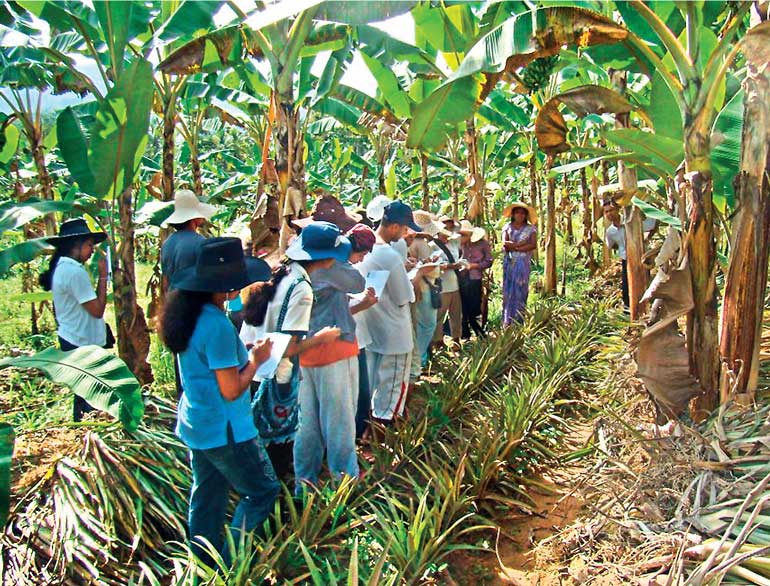Thursday Dec 18, 2025
Thursday Dec 18, 2025
Wednesday, 13 July 2016 00:05 - - {{hitsCtrl.values.hits}}

Introduction
 With more than 20 qualified researchers, more than 100 research projects and Rs. 200 million annual expenditure, the Department of Export Agriculture is geared towards innovative and timely research.
With more than 20 qualified researchers, more than 100 research projects and Rs. 200 million annual expenditure, the Department of Export Agriculture is geared towards innovative and timely research.
It is producing some interesting research findings every year aiming to address the issue of the smallholder. Almost all of the research work is focused on plant genetics, filed management, pest and disease management and post-harvest.
The Ministry of Primary Industries is hoping to double export earnings by 2020, therefore it is interested in bringing the research findings to a commercial platform. This could be through the development of high-yielding varieties, developing commercially viable filed management practices (such as innovative irrigation mechanisms), commercially possible pest management mechanisms and post-harvest technologies.
Therefore the important questions to be asked are:
(1)How much of this research is industry focused?
(2)What barriers exists and what can be done to bring these research findings to a commercial platform?
Scientificresearch vs. economics
The research work at the Department of Export Agriculture is driven by the requests made to the extension division by the farmers. There is nothing wrong with the approach, smallholders issues need to be addressed through research. However, there are several issues.
The research work, especially which is focused on the plant genetics, building new planting materials, filed management practices and pest and disease management takes a considerably longer time. These research projects on average take about four to 10 years to complete.
The research work first needs to be done at the nursery level, and then it has to be practiced at the field level. These fieldsare mostly the testing fields owned by the Department of Export Agriculture and sometimes they are owned by the private sector.
For a crop like pepper, which gives yield in seven to eight months, the average time to recommend a new variety would be around eight to 10 years. Therefore the money spent is enormous because time is money. As a result, it is important to look at what other countries have done and look for innovative ways that minimise the time commitment. It is also important to get things right from the beginning so extra expenditures can be minimised.
Most of the time the economic aspects of the research is given a less priority. It does not make sense to develop a very efficient irrigation system that preserves soil moisture if it is too costly for a small holder to adopt. In such a case the broader objective of the research is achieved, which is the “efficient water management system to preserve soil moisture” but the practical aspect would be lost.
One important thing to remember is that small holder demands low cost methods. If the solution is costly the adaptation will be low, unless there is a subsidy in place. A small holder needs to be able to evaluate the opportunity cost of a particular solution.
For example, if the new irrigation system provides an “X%” increase in the yield and the cost increase for new irrigation system is “Y%”, the latter obviously has to be lower. The things might get pretty ugly if the farmer is hoping to fund the new irrigation system through credit. Then we need to take in to account the interest payments as well, but let’s not go there. The bottom line is that the small holder must see an “economic benefit” out of the new irrigation system.
Research ownership is very crucial. Breeders at the Department of Export Agriculture are so talented. One would be amazed to see the genetic related work they do. However there is little clarity on who would own the rights to the newly developed genetic materials.
Since the National Science Foundation (NSF), Council for Agricultural Policy (CARP) or any other Government entitypurely funds these research works, one would argue that the rights are with the State. However, one should understand and appreciate the time and effort put by these scientists on developing these varieties, and I believe they needed to be compensated or at least acknowledged.
But to my understanding the current law does not allow rights on plant material development to be given to the scientists, therefore the rights to new varieties are vested under the Department of Export Agriculture itself. However, the patent systems is there for any other scientific development such as a “new post-harvest product or a machine”, rights will be given to the researcher. The export agriculture sector can’t survive without these good quality breeders and we need to take care of the genetic matter we develop.
Program evaluation in scientific research is very important. The research program must have a monitoring and evaluation system in built, which goes hand in hand. For this, economic principles are essential.
For example when a particular pest and disease control method is introduced, it is important to evaluate that in terms of relevance, efficiency, effectiveness, sustainability and impact. Just because the disease is controlled in a given instance, it does not mean that the intervention is successful. A proper impact evaluation is necessary to assess that, and most research work at the Department of Export Agriculture lacks that component.
One way to address such an issue is to plan ahead. Before releasing a solution for pest and disease a program can be planned, preferably a quasi-experiment, so at the end of the day a statistical analysis cane be carried out to see the impact. It is possible to implement something like a Difference In Difference (DID) analysis to assess the impact, if things are planned ahead.
How to ensure Return on Research (ROR)
We are used to taking about Return on Investment (ROI). In this article my focus is rather on Return on Research (ROR). We make investments with an aim of making returns at the end of the day, and they are in monetary terms. However, in scientific research, like what is done at the Department of export agriculture, the focus is not always on returns.
For example, let’s look at a pest and disease control research. Let’s assume a research program geared towards controlling a disease in coffee using another microorganism. The main objective of such research work is to develop and assess the effectiveness of a particular microorganism. Therefore in the short-term the main aim is the disease control. Increase yield and profits are a far-fetched deal.
However, an intermediate step might have a higher commercial appealing. For example developing a “growth medium for the desirable microorganism”. This medium can be commercially produced and sold at a reasonable price. Now the Department of Export Agriculture might not be interested in production, however the private sector might buy the rights to produce that for a good price. Hence we are generating Return on Research (ROR) through markets. In scientific research it is important to understand where the money could be generated.
Let’s take another example. The research work at the department of Export Agriculture looks at “different fertiliser mixtures” that provide best yields and quality. Once a recommendation is made, it is important to look at the feasibility of it. This means looking at whether farmers can have an uninterrupted supply or if they canmake it by themselves. If farmers can’t make it by themselves, then there is an opportunity to formulate a product that farmers can buy for a reasonable price.
Another example is the “development of efficient irrigation systems”. Most of the times these systems are not feasible for a small holder to make it by himself or herself. Rather they would be willing to pay a reasonable price if someone were to make it.
In the commercialisation process or ensuring the Return on Research (ROR), the important thing is the involvement of the private sector. It is clear that the Department of Export Agriculture would not go into the production of a “commercial fertiliser or a commercial irrigation system or an integrated pest management package”. But it is possible for them to connect their research work with the private sector.
Getting the private sector involved can be under different arrangement modalities. For example, the private sector can buy the rights to commercially produce or they could fund the research work. Or the arrangement could be a Public-Private Partnership.
Incentives might limit adaption of research findings
I mentioned in the beginning that small holder demands the research work from the Department of Export Agriculture. Once a solution is provided, the adaptability could be low due to many reasons. However, one common denominator is the “incentives”. It is important to understand the incentives before a particular research starts.
Let’s look at an example. Thrashing an important activity in pepper production. Most of the time raw pepper is harvested and thrashed before selling to the first handler and it is a time and labour consuming activity. Therefore the request by the small holder is to manufacture a machine that can do the trashing quickly.
Another aspect of this is the conventional trashing by foot would contaminate the pepper and the machine would not. A subsidy program was also introduced so that farmers can accommodate the machine. Even with the subsidy the adoption rate was low. The million dollar question is ‘Why?’
The majority of the pepper goes to India. India does not discriminate pepper based on quality. Other words, there isn’t a price premium for quality pepper. Whether pepper is thrashed by foot or machine the price received is same. Hence even with a subsidy, there isn’t enough incentive for a farmer to invest in a thrashing machine.
The small holder saw it as an “additional cost” only. The incentives are not visible by the distorted market price, giving rise to what we call ‘The Small Holder Quality Penalty’ (SHQP). At the end the investments by the small holder is low, not yielding Return on Research (ROR).
Conclusions
In the proposal writing phase of the research, it is important to find out where the Return on Research (ROR) would come from. As soon as they are identified, it is important to look for private sector involvement either through research funding or commercialisation.
The smallholder should be given enough incentive to adopt the research findings. Just because it is demanded it does not necessary mean they would adopt it. It is important to evaluate and try to identify the possible Small Holder Quality Penalties (SHQP).
Research work that the Department of Export Agriculture does with minimum human and physical capital is impressive. It is important that their determined work is put in to better use.
The writer is an independent research economist. The article is based on the observations made as a panellist at the ‘Research Symposium of the Department of Export Agriculture’. The author can be contacted through [email protected]